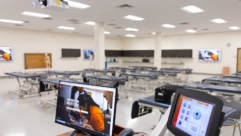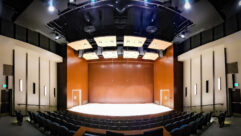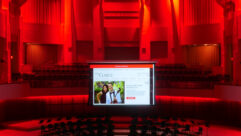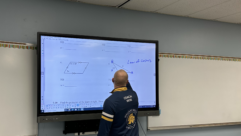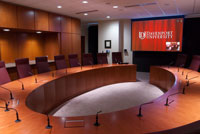

Case Study: Davenport University
May 17, 2011 3:10 PM,
By Don Kreski
High-bandwidth control infrastructure
More on Davenport University
Video: Inside the Davenport University Installation
“We wanted to make sure we had the right infrastructure in place not only for the technology that was installed but for the technology of the future.”
That’s Ignacio Perez, Information Technologies Services project manager at Davenport University in Grand Rapids, Mich., talking about the AV systems in the university’s newest building, the Robert W. Sneden Center.
The Sneden Center features seven high-tech classrooms, three executive meeting rooms, and faculty and administrative offices. “We designed the systems in the Sneden Center to be as future proof as possible,” explains Kirk Griffes, systems engineer and programmer for Michigan-based BlueWater Technologies. “They had to be state-of-the-art and easily added on to, since the university did not have the budget to do everything they wanted in the initial build-out, especially in their new auditorium.”
The new auditorium and executive boardroom are the two keystones of the project, so Griffes anchored their AV systems with a Crestron DigitalMedia infrastructure, including Crestron cabling and matrix switchers. “DigitalMedia allows us to transport and switch digital audio and video signals over category-type cable,” Griffes explains. To handle the high bandwidth required for full 1080p high definition, Crestron created its own cable standard. “It’s not Cat-5 or Cat-6, although similar. It’s a super cat cable that holds to IP standards but supports an even higher bandwidth.”
To support the various types of events to be held in the auditorium, Griffes designed a system that includes dual 7,000-lumen 1080p Epson projectors shooting to 165in. Draper screens; a sound system based on a Biamp AudiaFlex CM processor and 16,000W of Crown Audio amplification, 70V Posh Speaker Systems ceiling speakers for voice, and Renkus-Heinz speakers and subwoofers for program audio; two custom podiums; wired and wireless microphones; plus computer, Blu-ray, and broadcast sources.
1
Case Study: Davenport University
May 17, 2011 3:10 PM,
By Don Kreski
High-bandwidth control infrastructure

“The university plans to add streaming, production, and distance learning capabilities, so we had to design a system we could upgrade,” Griffes says.
With these needs in mind, Griffes put all of the audio and video signals on Crestron DM-CBL-NP-SP DigitalMedia cable and pre-terminated CRESFIBER-DUAL-SC fiber, switching them with a DM-MD8X8 matrix switcher. The use of DigitalMedia technology ensures that the university will not bump into any problems with HDCP copy protection or other issues associated with HDMI-based high-definition systems.
Sometime this year, Griffes expects to install JL Cooper Electronics motorized fader controls, which BlueWater Technologies will tie into the Crestron PRO2 processor to interface with the auditorium’s sound and lighting systems. “These come in blocks of eight channels and can be linked together to make a handsome console that’s easier to use in a live environment than multiple sliders and buttons on a touchpanel,” Griffes explains. “It won’t be a concert system, but we will be able to support smaller performances, say of a vocalist or a string quartet.” If the university did decide to book a rock band, they would have the capability to plug a concert soundboard and other components into the system.
The primary use of the boards, however, will be to better handle video streaming and video production. The university is looking at HD cameras and a rich media system record lectures and events. “One of the things they want to do is to provide high-definition video feeds to the press,” Griffes says. “Say the governor comes to speak or they host another Congressional debate. They could provide the necessary feeds in MPEG-4 or HD-SDI format to the production trucks.”

This level of production will require an expert at the controls, so Griffes installed a 15in. Crestron V15 V-Panel touchscreen in the equipment area for the technical operator to use. He also designed the system to work on a day-to-day level without a technician. “We put a second 15in. V-Panel in the main podium so that the presenter can control everything,” he says. Griffes also expects to add annotation capabilities and multiple HD preview windows to the touchpanels through some programming and a simple upgrade to Crestron’s extreme DGE-2 graphics engine.
In the executive boardroom, Bluewater installed high-definition videoconferencing and digital AV presentation capabilities so the university can interact regularly with its 14 other campuses throughout Michigan. Griffes designed this system on a Crestron DigitalMedia backbone, using Crestron DM-CBL-NP-SP cable and a DM-MD8X8 matrix switcher. Griffes based the videoconferencing system on a Tandberg C40 codec, using a Tandberg PrecisionHD camera and an Audio-Technica ES935SML6 MicroLine condenser mic. An AudiaFlex CM processor handles all of the sound processing, including echo cancelation and mix-minus voice reinforcement. A 4,000-lumen Epson projector and a 123in. Draper screen serve as the video display. Sources include Blu-ray, dedicated computer, laptop inputs, and the university’s video distribution system, which carries cable news and television plus campus programming. A Crestron AV2 control processor with a TPS-6X Wi-Fi touchpanel brings simple touchscreen control to the whole boardroom.
So far the room has been used only for board and executive meetings, but the intent is to open it up to various kinds of administrative and faculty meetings. “We wanted a space that was very accessible and easy to use,” Perez explains. “It’s important to us that anyone can use the technology without being afraid to try things out.”
2



